Sydbank Bundle
Unraveling Sydbank: How Does This Danish Banking Giant Thrive?
Sydbank, a key player in the Scandinavian financial scene, offers a comprehensive suite of services to a diverse clientele. Its impressive financial performance, including a profit before tax of DKK 2,878 million in Q1 2024, sparks curiosity about its inner workings. Understanding Sydbank SWOT Analysis is crucial for investors, customers, and industry watchers alike.
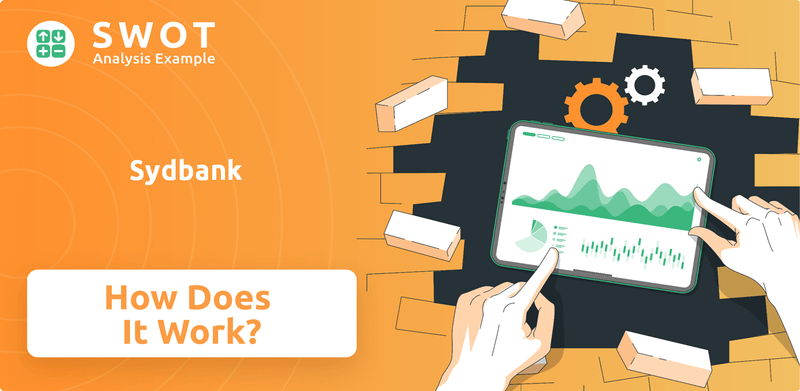
This exploration of Sydbank operations delves into its value creation, revenue generation, and competitive strategies within the dynamic Danish bank landscape. By examining its business model, we gain critical insights into its strategic direction and future prospects, helping you navigate the complexities of banking in Denmark and beyond. Whether you're researching Sydbank stock price, exploring Sydbank services, or seeking information on Sydbank customer service contact, this analysis provides a foundational understanding.
What Are the Key Operations Driving Sydbank’s Success?
Sydbank's core operations revolve around delivering a wide array of financial services to both private and corporate clients, primarily in Denmark and Northern Germany. This encompasses traditional banking, asset management, insurance, and real estate services. The bank's operational model is built on a robust digital infrastructure, enhanced by a network of physical branches, ensuring accessibility and personalized service.
The value proposition of Sydbank is centered on providing tailored financial solutions and fostering strong customer relationships. This is achieved through a combination of digital convenience and personal interaction. The bank's regional focus, particularly in Denmark and Northern Germany, allows for a deeper understanding of local market needs, offering a competitive edge.
The integration of various financial services under one roof, coupled with its regional specialization, offers a unique and effective approach compared to competitors, translating into comprehensive financial solutions and strong customer loyalty.
Sydbank offers a comprehensive suite of banking services. These include daily banking, savings accounts, and various loan products for private customers. Corporate clients benefit from business financing, cash management, and international trade finance solutions.
The bank leverages a strong digital infrastructure. This includes online banking platforms and mobile app features. A network of physical branches across Denmark and Northern Germany complements the digital offerings, ensuring accessibility and personalized service.
Sydbank focuses on building strong customer relationships. This is achieved through personalized financial advice and tailored solutions. The bank aims to provide a high level of customer service across all its offerings.
Sydbank's focus on the Danish and Northern German markets is a key differentiator. This regional specialization allows the bank to understand and meet the specific needs of its customers. This approach enhances customer loyalty.
Sydbank's operations are designed to provide a seamless customer experience. This includes a focus on digital innovation and maintaining a strong physical presence. The bank's financial performance reflects its commitment to these operational strategies.
- Digital Banking: Sydbank continues to invest in its digital platforms. This includes mobile app features and online banking services.
- Branch Network: The bank maintains a significant branch network. This supports customer service and provides a physical presence.
- Customer Service: Personalized customer service is a priority. This is achieved through trained staff and tailored financial advice.
- Financial Performance: The bank's financial results reflect the success of its operational strategies. For example, in 2024, Sydbank reported a net profit of DKK 1.4 billion.
For more insights into how Sydbank approaches its market and builds its brand, consider reading about the Marketing Strategy of Sydbank.
Sydbank SWOT Analysis
- Complete SWOT Breakdown
- Fully Customizable
- Editable in Excel & Word
- Professional Formatting
- Investor-Ready Format
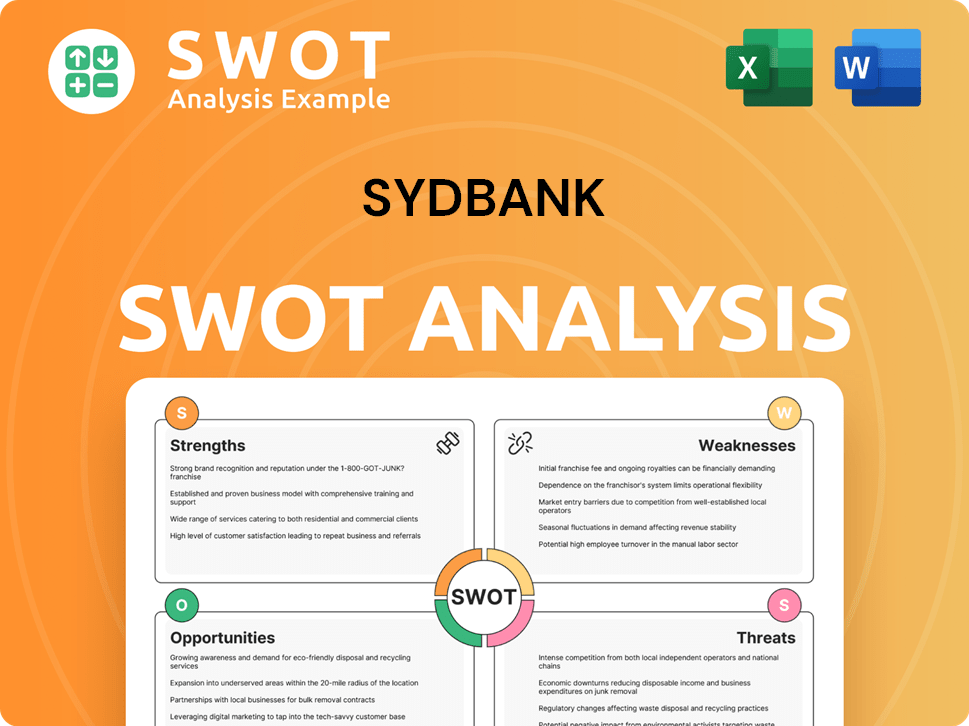
How Does Sydbank Make Money?
Understanding the revenue streams and monetization strategies of a financial institution like Sydbank is crucial for grasping its overall financial health and operational approach. The bank's ability to generate income and convert it into profit is pivotal for its sustainability and growth. This analysis delves into the core methods by which Sydbank creates value and maintains its financial stability.
Sydbank's financial performance is underpinned by several key revenue streams. These include net interest income, net fee income, and income from financial instruments. Each of these streams plays a significant role in the bank's overall profitability, reflecting a diversified approach to financial services.
The bank's monetization strategies involve a combination of approaches aimed at maximizing revenue from its customer base. These strategies include tiered pricing for services, cross-selling of financial products, and the bundling of services to enhance customer value. The bank's focus on both private and corporate clients allows it to diversify its revenue sources.
Net interest income is a primary revenue driver for Sydbank. It is derived from the difference between interest earned on loans and interest paid on deposits. In Q1 2024, this income stream was a significant contributor, amounting to DKK 2,126 million.
Net fee income is generated from various services such as payment processing, asset management, and advisory services. This income stream is a substantial component of Sydbank's revenue. In Q1 2024, net fee income was DKK 740 million.
Income from financial instruments contributes to the bank's overall profitability. This revenue stream can fluctuate based on market conditions. The bank actively manages its portfolio of financial instruments to optimize returns.
Sydbank employs tiered pricing strategies for certain services. This approach allows the bank to offer different pricing levels based on the type and volume of services used. This strategy helps in optimizing revenue from various customer segments.
Cross-selling involves offering additional financial products to existing customers. For example, customers using banking services might be offered asset management or insurance products. This strategy increases customer lifetime value.
Bundling services enhances customer value and increases wallet share. Sydbank may offer packages that combine multiple services, such as banking, investment, and insurance, at a combined price. This approach simplifies the customer experience.
The bank's strategic focus on both private and corporate clients allows for a balanced revenue mix. This diversification helps mitigate the risks associated with over-reliance on a single customer type or service. Over time, Sydbank has likely expanded its digital service offerings, potentially leading to an increase in fee-based income from digital transactions and advisory services. For more detailed information on Sydbank's operations, you can refer to this article about Sydbank operations.
Sydbank's financial health is supported by multiple revenue streams and monetization strategies.
- Net Interest Income: Primary income from the difference between interest earned on loans and interest paid on deposits.
- Net Fee Income: Revenue from services like payment processing and asset management.
- Income from Financial Instruments: Income that fluctuates based on market conditions.
- Tiered Pricing: Different pricing levels for various services.
- Cross-Selling: Offering additional products to existing customers.
- Bundled Services: Combining multiple services into packages for customer convenience.
Sydbank PESTLE Analysis
- Covers All 6 PESTLE Categories
- No Research Needed – Save Hours of Work
- Built by Experts, Trusted by Consultants
- Instant Download, Ready to Use
- 100% Editable, Fully Customizable
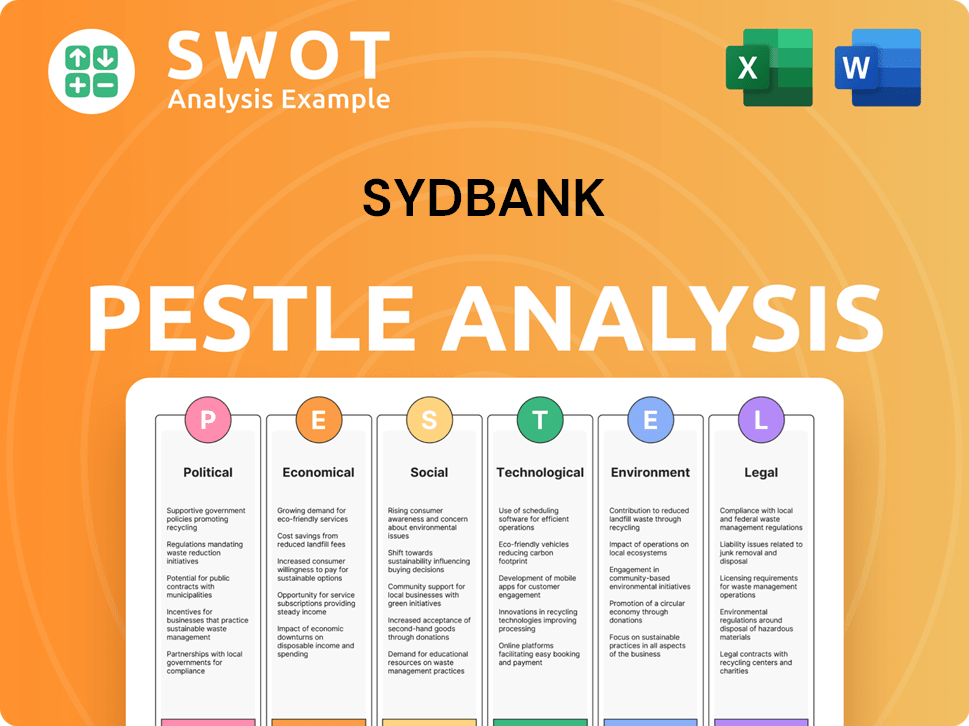
Which Strategic Decisions Have Shaped Sydbank’s Business Model?
Sydbank's journey is marked by key milestones and strategic shifts that have shaped its operational and financial performance. While specific product launches or revenue figures from 2024-2025 aren't detailed, the bank's consistent profitability, such as the DKK 2,878 million profit before tax in Q1 2024, indicates successful strategic execution. The bank's focus on its core markets, Denmark and Northern Germany, is a strategic decision to strengthen its position in familiar territories.
Operational challenges, including navigating interest rate fluctuations and adapting to evolving regulations, are inherent in the banking sector. Sydbank's consistent performance suggests effective risk management and adaptability. Its competitive advantages include a strong brand presence and customer trust in its domestic market, built over many years of service. The bank benefits from established customer relationships and a deep understanding of local economic conditions.
Furthermore, its ability to offer a full range of financial services, from traditional banking to specialized asset management and real estate, provides a holistic value proposition. Sydbank continues to adapt to new trends, including digitalization, by investing in technology to enhance its digital banking platforms and improve customer experience. For more information about Sydbank's strategic approach, consider reading about the Growth Strategy of Sydbank.
Sydbank has a history of steady growth and adaptation. The bank has consistently demonstrated financial stability, as evidenced by its Q1 2024 profit before tax of DKK 2,878 million. This profitability reflects successful navigation of economic cycles and strategic investments.
The bank's strategic focus on its core markets, Denmark and Northern Germany, is a key move. This concentration allows for deeper market penetration and efficient resource allocation. Sydbank has also invested in digital banking platforms to enhance customer experience and operational efficiency.
Sydbank's strong brand reputation and customer trust are significant advantages. Its comprehensive service offerings, including traditional banking, asset management, and real estate services, provide a competitive edge. The bank's focus on customer relationships and local market knowledge further strengthens its position.
Sydbank's financial performance, particularly its profit before tax of DKK 2,878 million in Q1 2024, demonstrates its ability to generate strong returns. The bank’s focus on core markets and efficient operations contributes to its financial success. This consistent performance builds confidence in its long-term sustainability.
Sydbank's key strengths include its strong brand reputation, customer trust, and comprehensive service offerings. The bank's focus on its core markets and efficient operations contributes to its financial success. The bank's ability to adapt to new trends, such as digitalization, further strengthens its market position.
- Strong brand and customer trust within the Danish market.
- Comprehensive range of financial services, including asset management and real estate.
- Consistent financial performance, as demonstrated by the Q1 2024 profit before tax.
- Strategic focus on core markets for efficient resource allocation.
Sydbank Business Model Canvas
- Complete 9-Block Business Model Canvas
- Effortlessly Communicate Your Business Strategy
- Investor-Ready BMC Format
- 100% Editable and Customizable
- Clear and Structured Layout
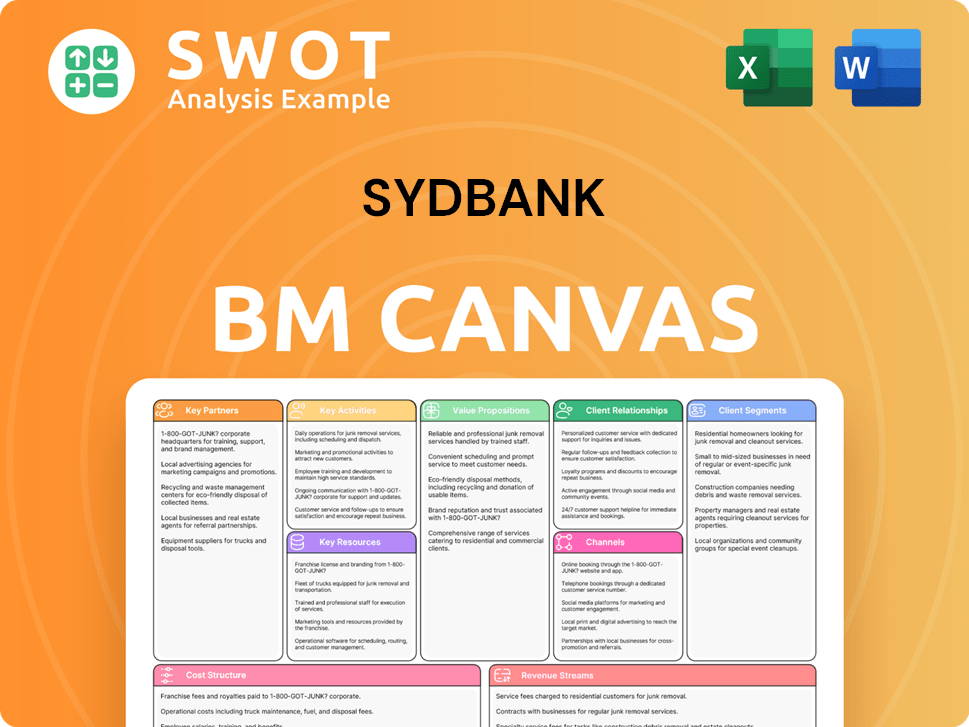
How Is Sydbank Positioning Itself for Continued Success?
In the realm of Danish banking, Sydbank holds a significant position. It competes with both larger national banks and smaller regional institutions, offering a comprehensive suite of financial services. This allows the bank to maintain a considerable market share, fostering strong customer loyalty within Denmark and Northern Germany. The Owners & Shareholders of Sydbank benefit from the bank's established presence.
Sydbank's strong capital position and liquidity, as highlighted in its 2024 annual report, are crucial indicators of its stability. This solid foundation allows it to navigate economic uncertainties. The focus on both private and corporate clients further strengthens its market position, offering a diverse range of services.
Sydbank is a key player in the Danish banking sector, competing with major national and smaller regional banks. It focuses on providing financial services to both private and corporate clients in Denmark and Northern Germany. This focus has helped maintain a significant market share and strong customer loyalty.
Sydbank faces risks from regulatory changes, such as stricter capital requirements. Competition from fintech companies and economic downturns also pose threats. Shifts in consumer preferences towards digital banking could also impact operations and revenue.
The bank is likely to continue investing in digitalization to enhance customer experience and operational efficiency. Exploring sustainable growth within its core markets is also a key strategic focus. Sydbank aims to sustain and expand profitability by adapting to market demands.
In 2024, Sydbank reported a robust capital position and liquidity, crucial for withstanding economic shocks. The bank's leadership emphasizes maintaining a strong financial position and delivering value to shareholders. This focus supports long-term growth and stability.
Sydbank is focusing on digitalization to enhance customer experience and operational efficiency. They are also exploring sustainable growth opportunities within their core markets, aiming to adapt to evolving market demands. The commitment to a customer-centric approach remains a priority.
- Continued investment in digital platforms and services.
- Expansion of sustainable financial products.
- Strategic partnerships to enhance service offerings.
- Focus on customer relationship management and loyalty.
Sydbank Porter's Five Forces Analysis
- Covers All 5 Competitive Forces in Detail
- Structured for Consultants, Students, and Founders
- 100% Editable in Microsoft Word & Excel
- Instant Digital Download – Use Immediately
- Compatible with Mac & PC – Fully Unlocked
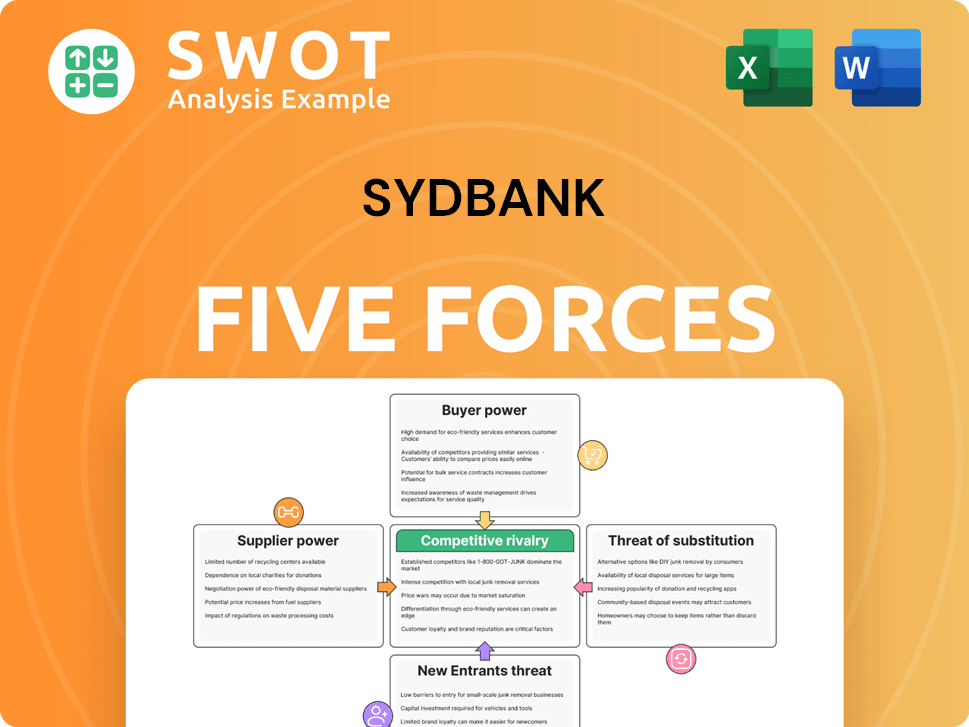
Related Blogs
- What are Mission Vision & Core Values of Sydbank Company?
- What is Competitive Landscape of Sydbank Company?
- What is Growth Strategy and Future Prospects of Sydbank Company?
- What is Sales and Marketing Strategy of Sydbank Company?
- What is Brief History of Sydbank Company?
- Who Owns Sydbank Company?
- What is Customer Demographics and Target Market of Sydbank Company?
Disclaimer
All information, articles, and product details provided on this website are for general informational and educational purposes only. We do not claim any ownership over, nor do we intend to infringe upon, any trademarks, copyrights, logos, brand names, or other intellectual property mentioned or depicted on this site. Such intellectual property remains the property of its respective owners, and any references here are made solely for identification or informational purposes, without implying any affiliation, endorsement, or partnership.
We make no representations or warranties, express or implied, regarding the accuracy, completeness, or suitability of any content or products presented. Nothing on this website should be construed as legal, tax, investment, financial, medical, or other professional advice. In addition, no part of this site—including articles or product references—constitutes a solicitation, recommendation, endorsement, advertisement, or offer to buy or sell any securities, franchises, or other financial instruments, particularly in jurisdictions where such activity would be unlawful.
All content is of a general nature and may not address the specific circumstances of any individual or entity. It is not a substitute for professional advice or services. Any actions you take based on the information provided here are strictly at your own risk. You accept full responsibility for any decisions or outcomes arising from your use of this website and agree to release us from any liability in connection with your use of, or reliance upon, the content or products found herein.